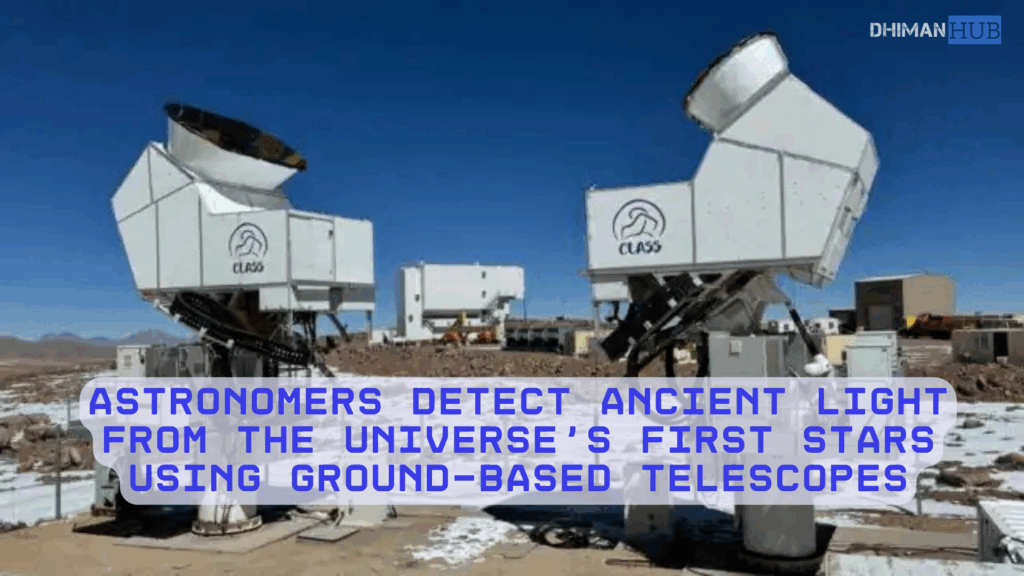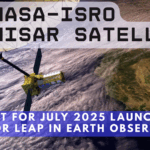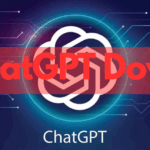Astronomers Detect Ancient Light from the Universe’s First Stars Using Ground-Based Telescopes
June 12, 2025 — In a landmark achievement, astronomers have detected radio signals from the Cosmic Dawn, the era when the universe’s first stars ignited, using Earth-based telescopes for the first time. This breakthrough offers humanity its earliest glimpse into the birth of starlight—over 13 billion years ago.

What is the Cosmic Dawn?
The Cosmic Dawn refers to the period roughly between 180 million and 400 million years after the Big Bang, when the first stars and galaxies formed. Their intense ultraviolet radiation began ionizing the surrounding hydrogen gas, ending the cosmic “dark ages” and making the universe transparent to light. This epoch laid the foundation for all subsequent cosmic structure.
The Discovery
The signal was observed using the Cosmology Large Angular Scale Surveyor (CLASS), an array of telescopes located in Chile’s Atacama Desert. The discovery was led by Professor Tobias Marriage, a physicist and astronomer at Johns Hopkins University, and announced on June 12, 2025.
The CLASS team detected a faint dip in radio frequencies at 78 MHz, a signature of neutral hydrogen altered by the first stars. This signal is about a million times fainter than typical cosmic microwave background (CMB) radiation, making it notoriously difficult to detect from Earth.
“People thought this couldn’t be done from the ground,” said Professor Marriage. “Overcoming those obstacles makes this measurement a significant achievement” (NDTV).
Why It Matters
This detection helps refine our understanding of reionization, the process by which early starlight re-ionized the universe’s hydrogen fog. It also provides clues about dark matter, neutrinos, and the timeline of galaxy formation.
“Better measurements of the universe help refine our understanding of dark matter and neutrinos,” said Charles Bennett, who led the WMAP mission (Phys.org).
A New Era in Ground-Based Cosmology
Until now, such observations were thought possible only from space. But CLASS’s success demonstrates that with the right technology and location, Earth-based instruments can rival their orbital counterparts. The CLASS telescopes operate in one of the world’s quietest radio environments, allowing for unprecedented sensitivity.
Historical Milestones in Cosmic Dawn Research
- 1965 – Discovery of the Cosmic Microwave Background (CMB) Arno Penzias and Robert Wilson accidentally discovered the CMB, the afterglow of the Big Bang, marking the first observational evidence of the early universe. NASA CMB Overview
- 2003 – Launch of NASA’s WMAP Mission The Wilkinson Microwave Anisotropy Probe mapped temperature fluctuations in the CMB, helping define the age and composition of the universe. WMAP Mission Summary
- 2013 – ESA’s Planck Mission Results Planck provided the most detailed map of the CMB to date, refining estimates of the universe’s age and confirming the timeline of the Cosmic Dawn. ESA Planck Results
- 2018 – EDGES Experiment Detects 21-cm Signal The EDGES team in Australia reported a possible detection of the 21-cm absorption line from Cosmic Dawn, though the result remains debated. Nature Article on EDGES
- 2022 – James Webb Space Telescope (JWST) Begins Observations JWST launched in December 2021 and began capturing images of galaxies from the Cosmic Dawn in mid-2022. NASA JWST Timeline
- 2025 – CLASS Detects Polarized Light from First Stars The CLASS telescope array detects a faint polarization signal from the Cosmic Dawn, confirming Earth-based detection is possible. Phys.org Report
Looking Ahead
Projects like the Cosmic DAWN Survey, which combines data from the Euclid Space Telescope and JWST, aim to map the earliest galaxies and black holes. These efforts will deepen our understanding of how the universe transitioned from darkness to light.
Further Reading
- NDTV: Scientists Observe Light of Cosmic Dawn
- Phys.org: Earth-based telescopes offer a fresh look at Cosmic Dawn
- MSN Science: CLASS telescope captures first starlight
- Cosmic DAWN Survey (Caltech/IPAC)














